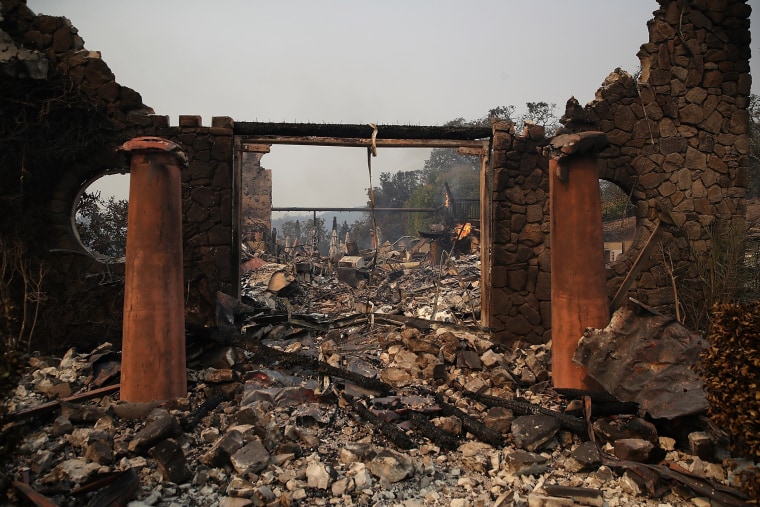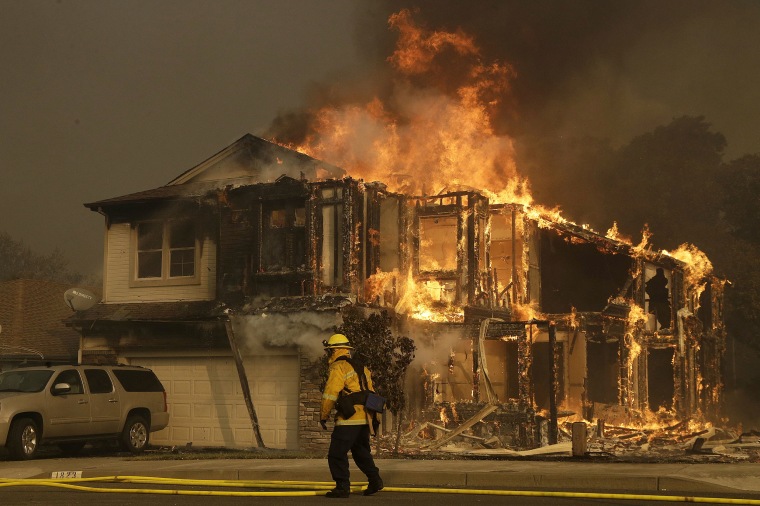LOS ANGELES — It may take weeks to determine the spark that touched off each of the firestorms that consumed hunks of more than a dozen California communities this week.
But the consensus in the scientific community is that the conditions that cleared a path for the tsunami of flame were made by humans. Decades of aggressive firefighting left too much fuel on the ground. And more than a century of carbon emissions exacerbated the state’s drought and the record high temperatures that baked brush and timber to an explosive dryness.
The damage from the wind-driven flames — which destroyed thousands of buildings and killed at least 17 people — is also more grievous because of another man-made initiative: building more and more homes in hilly communities adjacent to brush and woodlands.
Thousands of residents in Northern California remained out of their homes Tuesday because of evacuation orders, and the smoke from fires at the north end of San Francisco Bay was so thick that people 50 miles away, in Oakland and nearby communities, wore bandanas and white surgical masks.
“It’s very clear that the increasingly hot summers are the product of climate change,” said Daniel Swain, a climate scientist at the University of California, Los Angeles. “And it’s clear that human influence has an impact on the climate system in the American West and more broadly. That increases the risk of fire and the overall acreage burned when we get these conditions.”

Fires that would have once leapt from tree to tree and ridge to ridge now increasingly bound across rooftops and from one subdivision to the next. “With all this vegetation in what is known as the wildland-urban interface, it can be particularly dangerous,” Swain said.
A paper published by the National Academy of Sciences in 2012 found that the area expected to burn from 1984 to 2015 had nearly doubled — increasing by 4.2 million hectares — over the burn total that would have been expected in the absence of warming caused by humans. That’s an additional burn area 30 percent larger than the state of Maryland.
Man-made “climate change has emerged as a driver of increased forest fire activity and should continue to do so,” as long as fuels for the fires are not reduced, according to the same paper, written by John T. Abatzoglou and A. Park Williams of the University of Idaho.
So-called greenhouse gases like carbon dioxide have trapped heat in the earth’s atmosphere and led to higher temperatures. That has exacerbated droughts in places like California, which saw below average rainfall in 10 of the 11 seasons before 2016. (Rainfall is measured from July 1 to June 30 the following year.)
Last year’s wetter weather was substantial enough to produce robust grass and brush growth. In a process called “carbon dioxide fertilization,” vegetation tends to increase “simply through the intake of increasing atmospheric CO2,” according to a 2015 paper in the Bulletin of the American Meteorological Society that examined increased fire activity in California.
But the fresh vegetation from the winter of 2016 was soon visited by the summer’s unprecedented heat, symbolized by the September day that had San Francisco sweltering in 106-degree temperatures, an all-time high in the era of modern record keeping.
The summer furnace created a double whammy: Vegetation and trees that had dried out and become diseased during the long drought did not have time to recover, and both the older growth and the new vegetation from the recent rainy season were desiccated by months of relentless sun.
Increases in temperature and vapor pressure from 2000 to 2015 “significantly enhanced fuel aridity across western US forests [and] ... contributed to 75 percent more forested area experiencing high fire-season fuel aridity,” the University of Idaho researchers found. They concluded that that led to nine additional days per year of “high fire potential.”
Yet the magnitude of the burning sweeping the western U.S. is out of proportion to what would be expected, given the level of drought and warming alone, according to a paper by the National Academy of Sciences.
Climate and wildfire had been in relative sync for the last 3,000 years, with a few anomalous periods, according to the research, led by Jennifer R. Marlon, of Yale’s School of Forestry and Environmental Studies.
Man’s activity at first appears to have increased fires — with sparks from railroads touching off a large number of fires in the 1800s, for example, before the railroad companies began to spend more time clearing safety zones around their tracks. Then man’s habits turned and began to reduce the volume of flames. For one thing, livestock grazed away much of the fuel. For another, the early 1900s brought a public campaign for fire suppression after a series of deadly blazes. The U.S. created the national Forest Service, whose founding mission was to suppress fire on public lands.
“Consequently, there is now a forest ‘fire deficit’ in the western United States attributable to the combined effects of human activities, ecological, and climate changes,” Marlon’s paper concludes. Even the large fires at the end of the last century and the start of this one have not stopped the growth in this deficit — the amount of land that nature would tend to burn, in man’s absence.
Those natural forces show no sign of slowing, nor does the drive to put fires down as quickly as possible, saving homes and lives but potentially preserving fuel that will pose a greater threat in the future.
Andrew Blankstein contributed to this story.
